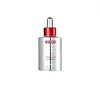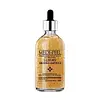What's inside
What's inside
 Key Ingredients
Key Ingredients

 Benefits
Benefits

 Concerns
Concerns

 Ingredients Side-by-side
Ingredients Side-by-side

Water
Skin ConditioningGlycerin
HumectantButylene Glycol
HumectantNiacinamide
SmoothingSodium Lactate
Buffering1,2-Hexanediol
Skin ConditioningGellan Gum
PEG-60 Hydrogenated Castor Oil
EmulsifyingEthylhexylglycerin
Skin ConditioningAdenosine
Skin ConditioningDisodium EDTA
Actinidia Chinensis Fruit Extract
EmollientEucalyptus Alba Leaf Extract
Skin ConditioningCentella Asiatica Extract
CleansingGold
Cosmetic ColorantPolygonum Cuspidatum Root Extract
AntioxidantPropanediol
SolventGlycyrrhiza Glabra Root Extract
BleachingCamellia Sinensis Leaf Extract
AntimicrobialSodium Hyaluronate Crosspolymer
HumectantRosmarinus Officinalis Leaf Extract
AntimicrobialFructan
Skin ConditioningChamomilla Recutita Extract
Skin ConditioningSodium Hyaluronate
HumectantHydrolyzed Glycosaminoglycans
HumectantGlycine
BufferingCaprylyl Glycol
EmollientPolysorbate 80
EmulsifyingSerine
MaskingGlutamic Acid
HumectantHydrolyzed Elastin
EmollientEctoin
Skin ConditioningHydrogenated Polyisobutene
EmollientBenzyl Glycol
SolventAspartic Acid
MaskingLeucine
Skin ConditioningOryza Sativa Extract
AbsorbentAstaxanthin
Skin ConditioningHydrolyzed Hyaluronic Acid
HumectantAlanine
MaskingLysine
Skin ConditioningArginine
MaskingTyrosine
MaskingPhenylalanine
MaskingValine
MaskingThreonine
Proline
Skin ConditioningIsoleucine
Skin ConditioningHistidine
HumectantMethionine
Skin ConditioningCysteine
AntioxidantPalmitoyl Tetrapeptide-7
Skin ConditioningHydrolyzed Sodium Hyaluronate
Skin ConditioningHydrolyzed Collagen
EmollientAcetyl Octapeptide-3
HumectantTripeptide-1
Skin ConditioningPalmitoyl Tripeptide-1
Skin ConditioningPalmitoyl Pentapeptide-4
Skin ConditioningCopper Tripeptide-1
Skin ConditioningAcetyl Hexapeptide-8
HumectantSodium Benzoate
MaskingSodium Acetylated Hyaluronate
HumectantHexapeptide-9
Skin ConditioningHydroxypropyltrimonium Hyaluronate
Hyaluronic Acid
HumectantDimethylsilanol Hyaluronate
HumectantNonapeptide-1
Skin ConditioningPentylene Glycol
Skin ConditioningHair Extract
Potassium Hyaluronate
Skin ConditioningTocopherol
AntioxidantAlcohol Denat.
AntimicrobialParfum
MaskingWater, Glycerin, Butylene Glycol, Niacinamide, Sodium Lactate, 1,2-Hexanediol, Gellan Gum, PEG-60 Hydrogenated Castor Oil, Ethylhexylglycerin, Adenosine, Disodium EDTA, Actinidia Chinensis Fruit Extract, Eucalyptus Alba Leaf Extract, Centella Asiatica Extract, Gold, Polygonum Cuspidatum Root Extract, Propanediol, Glycyrrhiza Glabra Root Extract, Camellia Sinensis Leaf Extract, Sodium Hyaluronate Crosspolymer, Rosmarinus Officinalis Leaf Extract, Fructan, Chamomilla Recutita Extract, Sodium Hyaluronate, Hydrolyzed Glycosaminoglycans, Glycine, Caprylyl Glycol, Polysorbate 80, Serine, Glutamic Acid, Hydrolyzed Elastin, Ectoin, Hydrogenated Polyisobutene, Benzyl Glycol, Aspartic Acid, Leucine, Oryza Sativa Extract, Astaxanthin, Hydrolyzed Hyaluronic Acid, Alanine, Lysine, Arginine, Tyrosine, Phenylalanine, Valine, Threonine, Proline, Isoleucine, Histidine, Methionine, Cysteine, Palmitoyl Tetrapeptide-7, Hydrolyzed Sodium Hyaluronate, Hydrolyzed Collagen, Acetyl Octapeptide-3, Tripeptide-1, Palmitoyl Tripeptide-1, Palmitoyl Pentapeptide-4, Copper Tripeptide-1, Acetyl Hexapeptide-8, Sodium Benzoate, Sodium Acetylated Hyaluronate, Hexapeptide-9, Hydroxypropyltrimonium Hyaluronate, Hyaluronic Acid, Dimethylsilanol Hyaluronate, Nonapeptide-1, Pentylene Glycol, Hair Extract, Potassium Hyaluronate, Tocopherol, Alcohol Denat., Parfum
Water
Skin ConditioningButylene Glycol
HumectantNiacinamide
SmoothingMethyl Gluceth-20
HumectantHydroxyethyl Urea
HumectantPolysorbate 20
EmulsifyingCaprylyl Glycol
EmollientCarbomer
Emulsion StabilisingTriethanolamine
BufferingPhenoxyethanol
PreservativeAllantoin
Skin ConditioningAmmonium Lactate
BufferingUrea
BufferingPanthenol
Skin ConditioningAdenosine
Skin ConditioningGold
Cosmetic ColorantDisodium EDTA
Parfum
MaskingCamellia Sinensis Leaf Extract
AntimicrobialLavandula Angustifolia Extract
Skin ConditioningRosmarinus Officinalis Extract
AntimicrobialSodium Hyaluronate
HumectantPortulaca Oleracea Extract
Skin ConditioningRehmannia Chinensis Root Extract
Skin ConditioningCI 19140
Cosmetic ColorantCI 15985
Cosmetic ColorantWater, Butylene Glycol, Niacinamide, Methyl Gluceth-20, Hydroxyethyl Urea, Polysorbate 20, Caprylyl Glycol, Carbomer, Triethanolamine, Phenoxyethanol, Allantoin, Ammonium Lactate, Urea, Panthenol, Adenosine, Gold, Disodium EDTA, Parfum, Camellia Sinensis Leaf Extract, Lavandula Angustifolia Extract, Rosmarinus Officinalis Extract, Sodium Hyaluronate, Portulaca Oleracea Extract, Rehmannia Chinensis Root Extract, CI 19140, CI 15985
 Reviews
Reviews

Ingredients Explained
These ingredients are found in both products.
Ingredients higher up in an ingredient list are typically present in a larger amount.
Adenosine is in every living organism. It is one of four components in nucleic acids that helps store our DNA.
Adenosine has many benefits when used. These benefits include hydrating the skin, smoothing skin, and reducing wrinkles. Once applied, adenosine increases collagen production. It also helps with improving firmness and tissue repair.
Studies have found adenosine may also help with wound healing.
In skincare products, Adenosine is usually derived from yeast.
Learn more about AdenosineButylene Glycol (or BG) is used within cosmetic products for a few different reasons:
Overall, Butylene Glycol is a safe and well-rounded ingredient that works well with other ingredients.
Though this ingredient works well with most skin types, some people with sensitive skin may experience a reaction such as allergic rashes, closed comedones, or itchiness.
Learn more about Butylene GlycolCamellia Sinensis Leaf Extract is derived from the leaves of the tea plant. Black tea, green tea, and oolong tea are all harvested from this plant.
This ingredient has many skin benefits:
This ingredient contains polyphenols, a strong antioxidant. Antioxidants help fight off molecules that damage skin cells.
On top of that, the antioxidants in green tea neutralize free-radicals from the sun. This gives the skin some extra UV protection, but should not replace sunscreen.
Many components of tea have anti-inflammatory properties.
Polyphenols and L-theanine help soothe the skin and reduce irritation. The caffeine in Camellia Sinensis Leaf Extract helps calm inflamed blood vessels.
Other compounds found in tea include: Vitamin Bs, linoleic acid, magnesium, calcium, iron, and zinc.
Research has shown both drinking Camellia Sinensis Leaf Tea and applying it to the skin can help boost skin elasticity and hydration. Studies also show using tea extract may reduce sebum, or oil, production.
Learn more about Camellia Sinensis Leaf ExtractCaprylyl Glycol is a humectant and emollient, meaning it attracts and preserves moisture.
It is a common ingredient in many products, especially those designed to hydrate skin. The primary benefits are retaining moisture, skin softening, and promoting a healthy skin barrier.
Though Caprylyl Glycol is an alcohol derived from fatty acids, it is not the kind that can dry out skin.
This ingredient is also used as a preservative to extend the life of products. It has slight antimicrobial properties.
Learn more about Caprylyl GlycolDisodium EDTA plays a role in making products more stable by aiding other preservatives.
It is a chelating agent, meaning it neutralizes metal ions that may be found in a product.
Disodium EDTA is a salt of edetic acid and is found to be safe in cosmetic ingredients.
Learn more about Disodium EDTAWe don't have a description for Gold yet.
Niacinamide is a multitasking form of vitamin B3 that strengthens the skin barrier, reduces pores and dark spots, regulates oil, and improves signs of aging.
And the best part? It's gentle and well-tolerated by most skin types, including sensitive and reactive skin.
You might have heard of "niacin flush", or the reddening of skin that causes itchiness. Niacinamide has not been found to cause this.
In very rare cases, some individuals may not be able to tolerate niacinamide at all or experience an allergic reaction to it.
If you are experiencing flaking, irritation, and dryness with this ingredient, be sure to double check all your products as this ingredient can be found in all categories of skincare.
When incorporating niacinamide into your routine, look out for concentration amounts. Typically, 5% niacinamide provides benefits such as fading dark spots. However, if you have sensitive skin, it is better to begin with a smaller concentration.
When you apply niacinamide to your skin, your body converts it into nicotinamide adenine dinucleotide (NAD). NAD is an essential coenzyme that is already found in your cells as "fuel" and powers countless biological processes.
In your skin, NAD helps repair cell damage, produce new healthy cells, support collagen production, strengthen the skin barrier, and fight environmental stressors (like UV and pollution).
Our natural NAD levels start to decline with age, leading to slower skin repair, visible aging, and a weaker skin barrier. By providing your skin niacinamide, you're recharging your skin's NAD levels. This leads to stronger, healthier, and younger looking skin.
Another name for vitamin B3 is nicotinamide. This vitamin is water-soluble and our bodies don't store it. We obtain Vitamin B3 from either food or skincare. Meat, fish, wheat, yeast, and leafy greens contain vitamin B3.
The type of niacinamide used in skincare is synthetically created.
Learn more about NiacinamideParfum is a catch-all term for an ingredient or more that is used to give a scent to products.
Also called "fragrance", this ingredient can be a blend of hundreds of chemicals or plant oils. This means every product with "fragrance" or "parfum" in the ingredients list is a different mixture.
For instance, Habanolide is a proprietary trade name for a specific aroma chemical. When used as a fragrance ingredient in cosmetics, most aroma chemicals fall under the broad labeling category of “FRAGRANCE” or “PARFUM” according to EU and US regulations.
The term 'parfum' or 'fragrance' is not regulated in many countries. In many cases, it is up to the brand to define this term.
For instance, many brands choose to label themselves as "fragrance-free" because they are not using synthetic fragrances. However, their products may still contain ingredients such as essential oils that are considered a fragrance by INCI standards.
One example is Calendula flower extract. Calendula is an essential oil that still imparts a scent or 'fragrance'.
Depending on the blend, the ingredients in the mixture can cause allergies and sensitivities on the skin. Some ingredients that are known EU allergens include linalool and citronellol.
Parfum can also be used to mask or cover an unpleasant scent.
The bottom line is: not all fragrances/parfum/ingredients are created equally. If you are worried about fragrances, we recommend taking a closer look at an ingredient. And of course, we always recommend speaking with a professional.
Learn more about ParfumSodium Hyaluronate is hyaluronic acid's salt form. It is commonly derived from the sodium salt of hyaluronic acid.
Like hyaluronic acid, it is great at holding water and acts as a humectant. This makes it a great skin hydrating ingredient.
Sodium Hyaluronate is naturally occurring in our bodies and is mostly found in eye fluid and joints.
These are some other common types of Hyaluronic Acid:
Learn more about Sodium HyaluronateWater. It's the most common cosmetic ingredient of all. You'll usually see it at the top of ingredient lists, meaning that it makes up the largest part of the product.
So why is it so popular? Water most often acts as a solvent - this means that it helps dissolve other ingredients into the formulation.
You'll also recognize water as that liquid we all need to stay alive. If you see this, drink a glass of water. Stay hydrated!
Learn more about Water